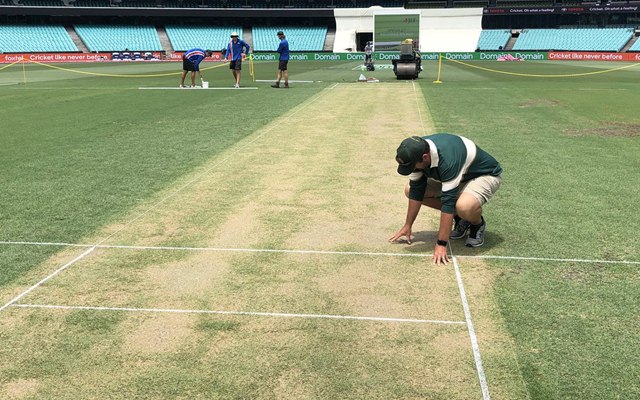SCG pitch. (Photo Source: Twitter)
The upcoming third and final Test clash between Australia and Pakistan at the Sydney Cricket Ground (SCG) on January 3 holds the promise of redemption for the notorious pitch woes haunting the venue. Adam Lewis, the SCG curator, exudes confidence in steering clear of a replication of the recent pitch debacle. Criticized for the nerve-wracking pitch during the late-November Marsh Sheffield Shield contest between New South Wales and Tasmania, which witnessed a flurry of wickets tumbling in a mere 63 overs, Lewis took the feedback seriously.
Tim Paine, former Test skipper, and Tasmania’s captain, termed the pitch “embarrassing”. Acknowledging the scrutiny, Lewis aims to dispel the shadow cast by the previous pitch fiasco. Despite earlier praise for his pitch in the preceding Shield game, Lewis remains focused on rectifying the misstep to ensure a more balanced and competitive surface for the upcoming Test showdown.
“With the short turnaround from the women’s doubleheader, we just couldn’t get enough water back into the wicket. We take (criticism) to heart because we put so much time and effort into it. We want to produce something that’s good for both the batter and the bowler. When it gets taken out of our hands, it’s hard. Hopefully, we won’t be in that situation. We learned from it, and we know what to do differently next time,” Lewis said as quoted by cricket.com.au.
Weather can wreak havoc on SCG’s redemption
The imminent New Year’s Test against Pakistan at the Sydney Cricket Ground (SCG) faces a looming challenge as unpredictable storms persist, keeping Lewis and his team vigilant. With further rain in the forecast, the threat of inclement weather looms large, posing a significant obstacle to spin-friendly conditions.
The SCG once celebrated as Australia’s prime spin Test venue, has seen a downturn, now statistically labelled the least favourable. In the last five Sydney Tests, spinners have managed 54 dismissals at an average of 44.02, with a strike rate of 85.6. Comparatively, only the Gabba shows a similar trend, where spinners have struggled, averaging over 32 and securing a wicket every 70 balls, aligning with the SCG’s recent struggles in fostering conducive conditions for spin bowling.
